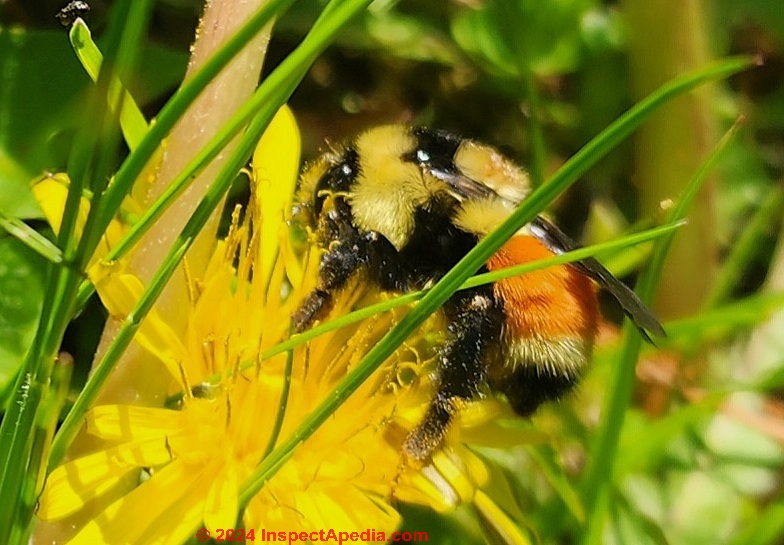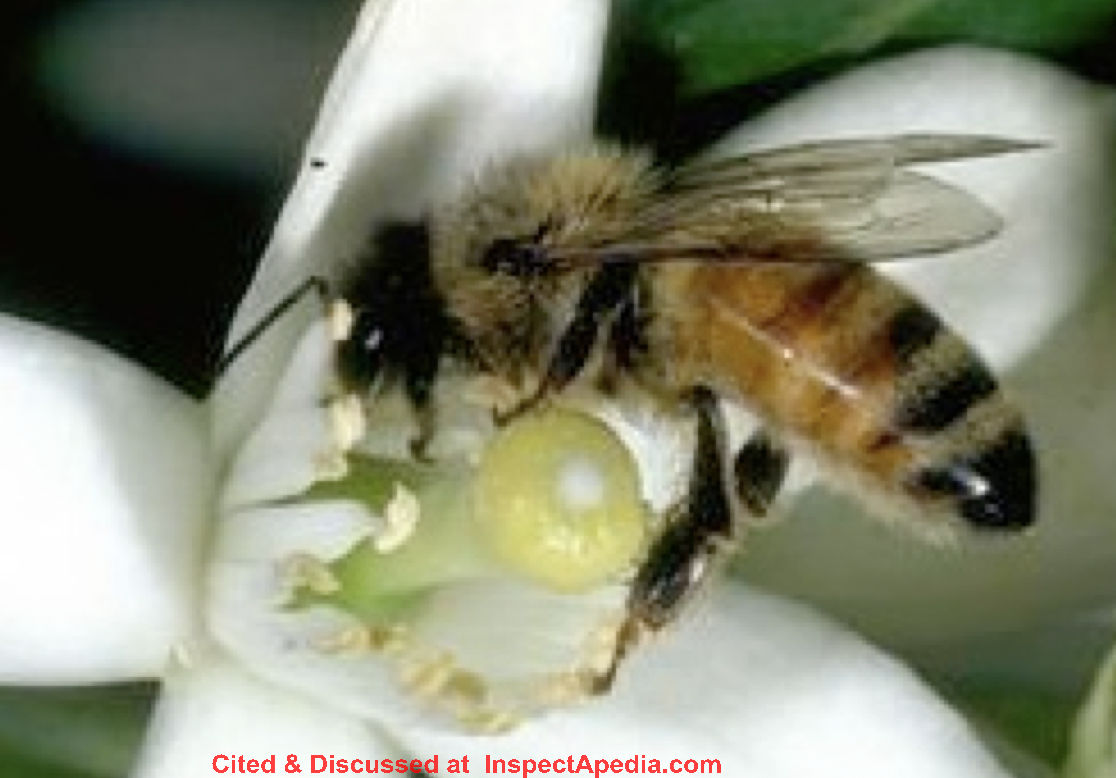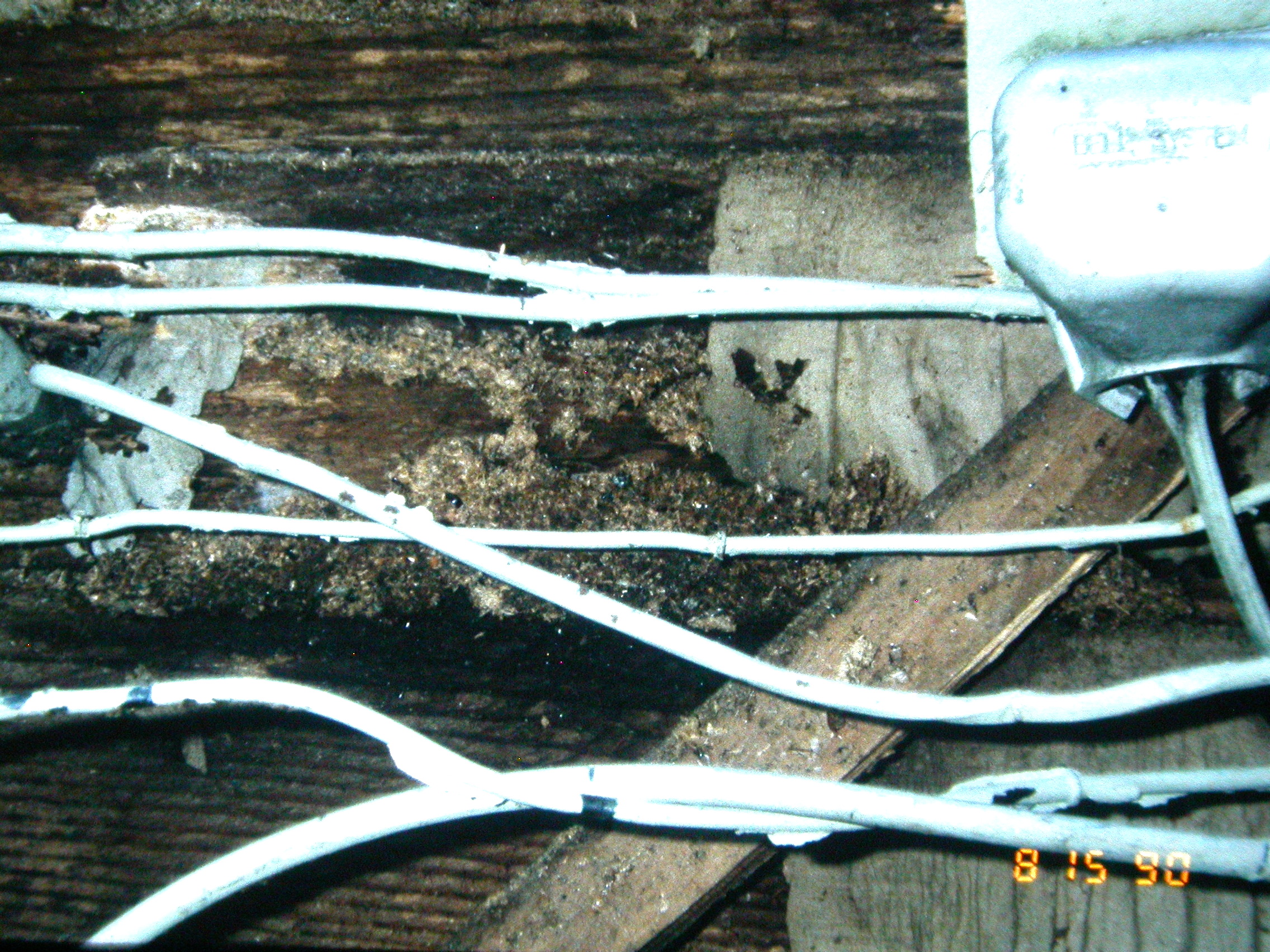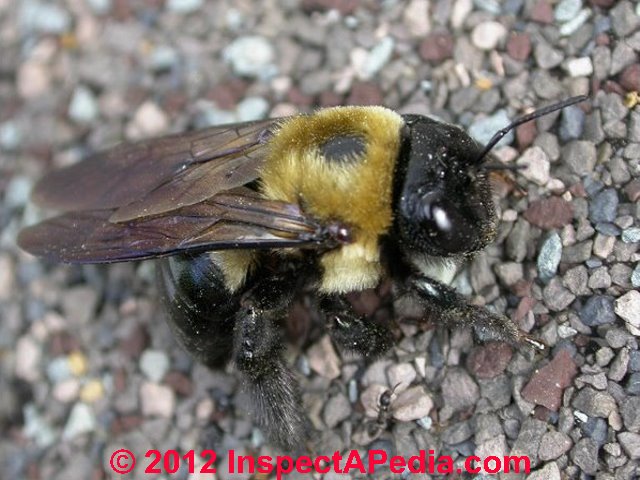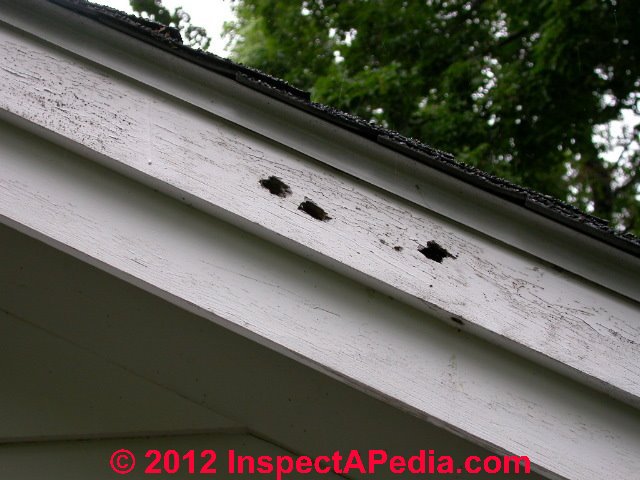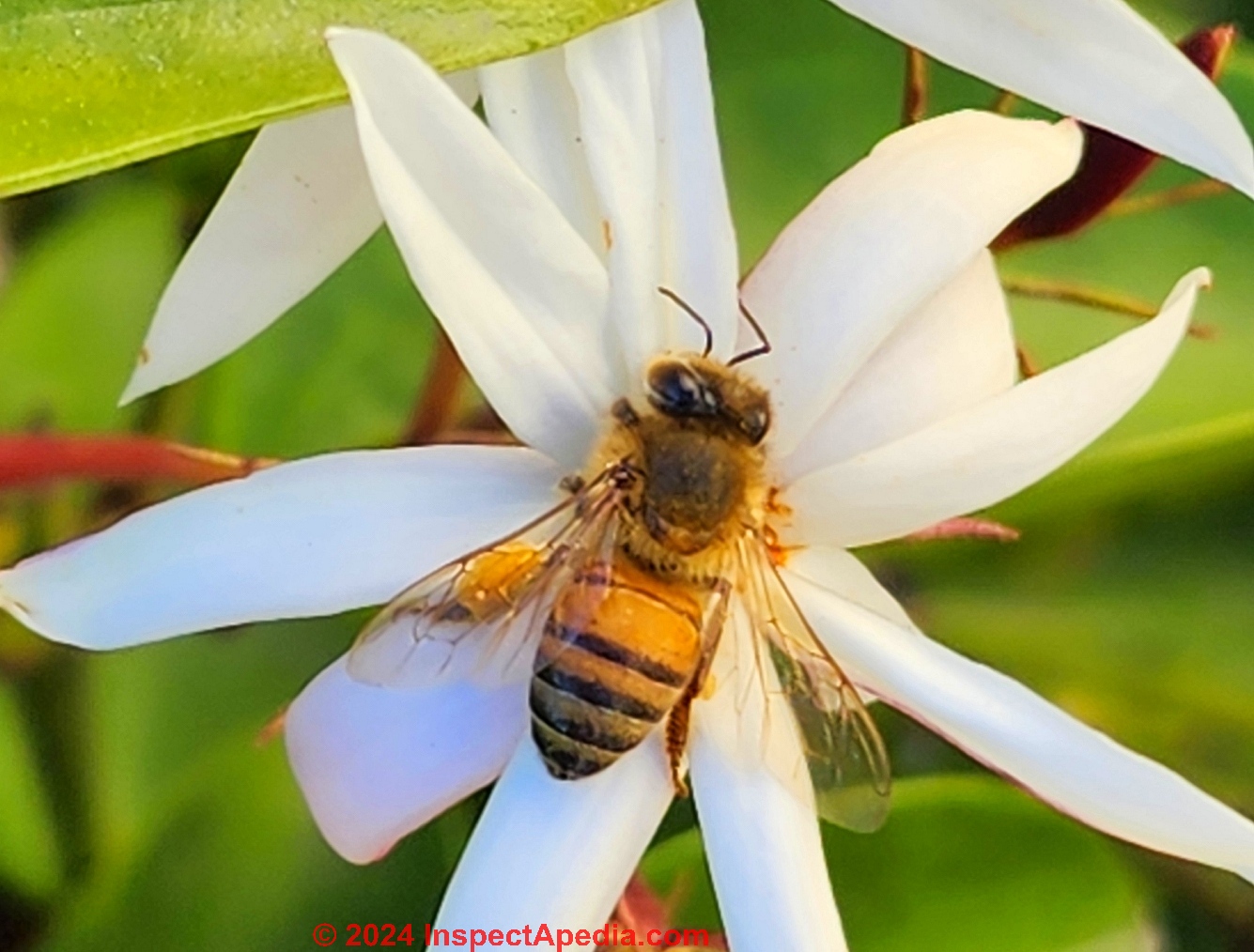 Honey bees in buildings
Honey bees in buildings
How do we safely remove a bee infestation
from a building?
What other bees may be mistaken for Honeybees?
- POST a QUESTION or COMMENT about this article topic
This article discusses the proper way to identify and then remove an unwanted honey bee colony inside a building wall or other cavity.
Page top photo: a Mexican honey bee collecting pollen from a false jasmine plant, photographed by the author in San Miguel de Allende, Guanajuato, Mexico, in January 2024.
InspectAPedia tolerates no conflicts of interest. We have no relationship with advertisers, products, or services discussed at this website.
- Daniel Friedman, Publisher/Editor/Author - See WHO ARE WE?
Honey Bees in Building Walls
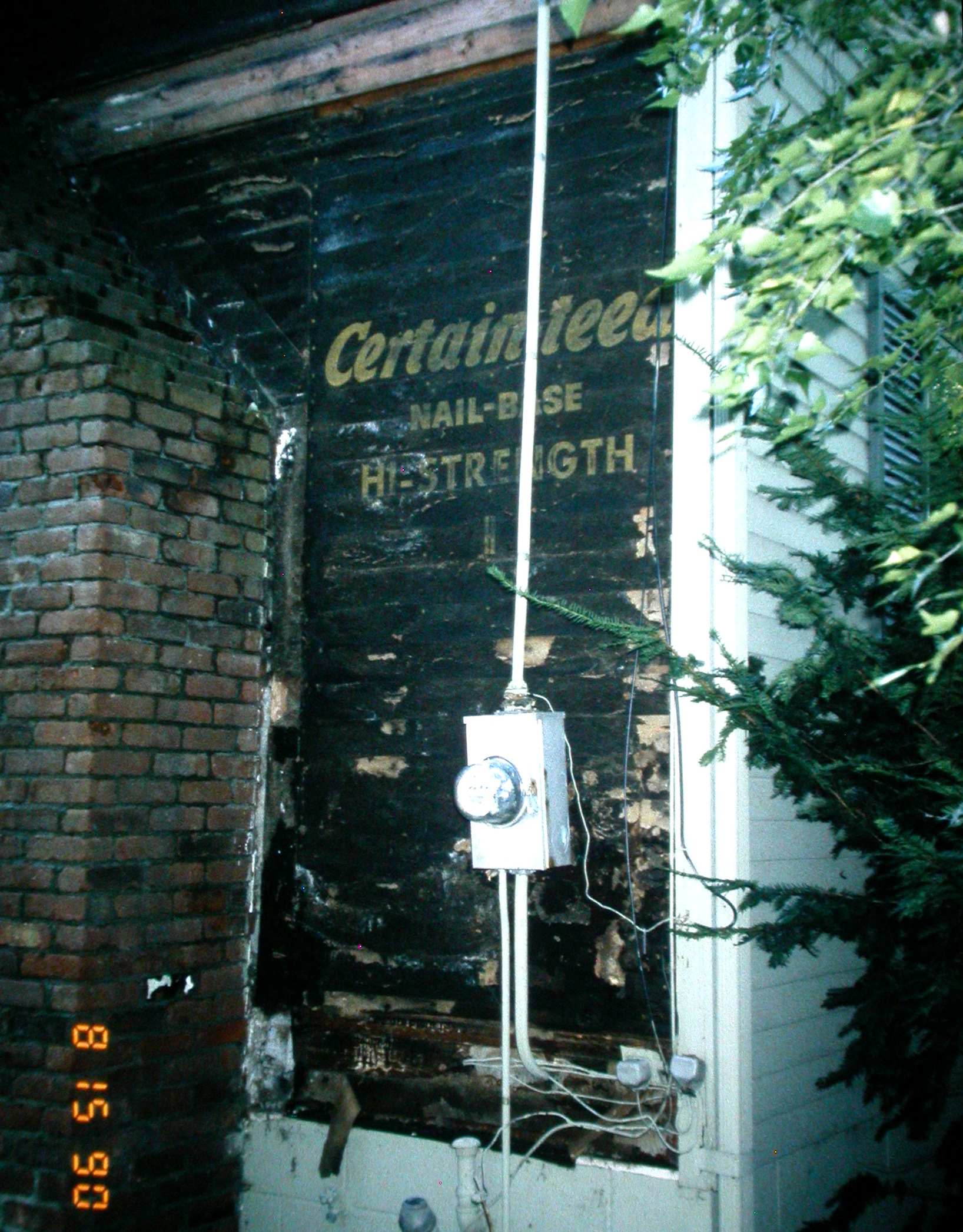 Bottom line: Watch out: it's best to avoid killing bees if you find them swarming in or around your home. But if bees are moving into your building there are two different situations:
Bottom line: Watch out: it's best to avoid killing bees if you find them swarming in or around your home. But if bees are moving into your building there are two different situations:
- If the bees are just moving in
(colonization in the last day or two) it may be possible hto ave a licensed pest control operator kill the colony by spraying an insecticide into the wall cavity. But if you wait longer the bees will have built honeycombs and will probably have increased in number.
- If there is an older, established bee colony in the building walls
it needs to be removed lest the remains of a killed colony both stain the building walls (melting honeycombs) and smell (dead bees).
In this case you will want to have the colony removed by a local beekeeper, usually without killing the bees.
The bee expert will open the wall, remove the honeycombs and dead bees, and may use a special bee-vacuum device to remove the live bees without killing them. The vacuumed bees and their honeycombs are then relocated to an acceptable place.
Given recent decimations of bee populations world wide we desperately need all the bees we can get. If you don't think there is a serious bee shortage, just take a look at people in China climbing trees with Q-tips to pollinate flowers on fruit trees.
Further, as we mentioned above, leaving a large clump of dead bees and honeycombs in a building wall can lead to a new series of complaints.
Photo above: months after a honeybee colony in this building had been killed by using a pesticide, the wall began to smell horrible. Ultimately the owners had to have the wall opened - in this case from the exterior side.
The dead bees along with a mess of honeycomb could then be removed. Had the owners known what to do sooner, the bees could have been removed without killing them and the extent of demolition and cleaning could have been less.
Details: Here, using reader Q&As to provide examples, we give advice for safe and effective removal of an invasion of honey bees who have taken up residence, perhaps even built honeycombs in a building cavity - most often building walls.
Reader Question: dark "growth" on the underside of subflooring, visible from basement - in a fern-like pattern - is this toxic mold?
 I found this odd stain pattern and black speckled material in my home. This is between the joists in my basement. I removed Sheetrock and insulation and found it. Thanks - M.R. 1010/17/2013 - updated 08/2024 - Ed.
I found this odd stain pattern and black speckled material in my home. This is between the joists in my basement. I removed Sheetrock and insulation and found it. Thanks - M.R. 1010/17/2013 - updated 08/2024 - Ed.
Reply:
I've been thinking about this and your photo - it's not something I've seen inside a building before; the growth pattern looks a bit like algae fronds, but on closer inspection I think those black dots may be fungal spores or ... something else (remains from an insect colony).
Mold growing in the pattern of a fern leaf or bracken pattern is not one I've found before.
On the side of what looks like a floor joist in your photo is what looks a bit like fungal growth of basidiomycetes - I don't know from such limited data; IF it's fungus there you should be looking for rot and structural damage;
Is that shiny property in the photo because the surfaces are wet? Where is this - geography, building type?
If you can collect suspect material on a tape sample (or if not try a razor blade and a clean plastic baggie or hard plastic container) you are welcome to send me a couple of samples and I'll take a look in the lab. For tape samples try the procedure (and address)
These may be marks from honeybee or feral bee honeycombs
Reader Michael Sears said: these may be marks from honeybee or feral bee honeycombs
I just saw your image inspectapedia.com/mold/Algae_or_Mold_939_MR_DJFs.jpg [the photograph just above]
I believe these are marks left over from the removal of a bee hive. The fern pattern is where the honey comb connected to the subfloor. - 4/7/2014,
Reply:
Thanks Michael. I took a look at several resources on how people remove honey bee colonies from buildings (traps are good but there are also special vacuums that don't harm the bees), before finding one of them, the E.C. Mussen (U.C. Davis) citation below that included photos not of the marks left behind by a honeybee comb on a building surface but of some feral beehive structures that could have made marks similar to those in the photo above.
Additional information is in a nice article by Keith Delaplane at the University of Georgia, also cited below.
In Delaplane's photos we see that some of the bee honeycombs built in a building wall cavity (and presumably similarly under a floor as in our photo above) are placed on-edge in a manner (see Delaplane, Fig. 3) --that might leave the marks we are discussing.
How to Remove Honey Bee Swarms or Colonies from Buildings
Photo: another useful pollinator, though not a honeybee, may be mistaken for one though it's in fact much larger and fatter. Our photo above shows a Tricoloured Bumble Bee or Orange-belted bumblebee (Bobmus ternarius) photographed in Two Harbors Minnesota in May, 2024.
- Adgaba N1, Al-Ghamdi AA, Chernet MH, Ali YA, Ansari MJ, Radloff SE, Howard RH, "An experiment on comb orientation by honey bees (Hymenoptera: Apidae) in traditional hives, J Econ Entomol. 2012 Jun;105(3):777-82. Article abstract:
The orientation of combs in traditional beehives is extremely important for obtaining a marketable honey product.
However, the factors that could determine comb orientation in traditional hives and the possibilities of inducing honey bees, Apis mellifera (L.), to construct more desirable combs have not been investigated. The goal of this experiment was to determine whether guide marks in traditional hives can induce bees to build combs of a desired orientation.
Thirty-two traditional hives of uniform dimensions were used in the experiment. In 24 hives, ridges were formed on the inner surfaces of the hives with fermented mud to obtain different orientations, circular, horizontal, and spiral, with eight replicates of each treatment.
In the remaining eight control hives, the inner surface was left smooth. Thirty-two well-established honey bee colonies from other traditional hives were transferred to the prepared hives.
The colonies were randomly assigned to the four treatment groups. The manner of comb construction in the donor and experimental hives was recorded.
The results showed that 22 (91.66%) of the 24 colonies in the treated groups built combs along the ridges provided, whereas only 2 (8.33%) did not. Comb orientation was strongly associated with the type of guide marks provided.
Moreover, of the 18 colonies that randomly fell to patterns different from those of their previous nests, 17 (94.4%) followed the guide marks provided, irrespective of the comb orientation type in their previous nest.
Thus, comb orientation appears to be governed by the inner surface pattern of the nest cavity. The results suggest that even in fixed-comb hives, honey bees can be guided to build combs with orientations suitable to honey harvesting, without affecting the colonies. - Berry, Jennifer, Kris Braman, Keith Delaplane, Mike Evans, Phillip Roberts and Alton Sparks, Protecting Georgia’s Pollinators, A state plan for promoting a large, healthy and diverse pollinator workforce [PDF] University of Georgia, College of Agriculture & Environmental Sciences - retrieved 2024/08/03 - local copy on file as Pollinator-Booklet-2-2016.pdf
Excerpt: Since 2006 U.S. beekeepers have been experiencing annual winter colony die-offs of around 30 percent, which is significantly higher than the self-reported “acceptable” loss rate of 18 percent.
Although hive numbers can be quickly restored in spring by splitting surviving colonies, the extra labor and expense pose a threat to the long-term availability of colonies for spring pollination.
Many factors have been implicated in bee decline, but scientists agree that the most important factors include:
parasitic Varroa mites
viruses spread by Varroa mites
pesticide exposure
habitat and forage degradation
- Camazine, Scott. "Self-organizing pattern formation on the combs of honey bee colonies." Behavioral ecology and sociobiology 28, no. 1 (1991): 61-76.
- Clemson Cooperative Extension, Hoad, William Michael, HONEY BEE COLONY REMOVAL from STRUCTURES [Website] retrieved 4/8/14, original source: http://www.clemson.edu/extension/beekeepers/ factsheets/honey_bee_colony_removal_from_structures.html - Link updated 2024/08/03 to https://www.clemson.edu/extension/beekeepers/fact-sheets-publications/honey-bee-colony-removal.html
- De Jong, David. "Orientation of comb building by honeybees." Journal of comparative physiology 147, no. 4 (1982): 495-501.
- Delaplane, Keith S, HONEY BEE SWARMS & BEES in WALLS [Website] update of circular 824 of the Cooperative Extension Service of Georgia and Ft. Valley State College, the USDA et als, July 1994, Keith S. Delaplane, Professor, Dept. Entomology,
University of Georgia, Athens, GA 30602 USA, retrieved 4/8/14, original source http://www.ent.uga.edu/bees/ HoneybeeswarmsandbeesinwallsHoneyBeeProgramCAESEntomologyUGA.html - Link updated 2024/08/03 to: https://bees.caes.uga.edu/beekeeping-resources/other-topics/honey-bee-swarms-and-bees-in-walls0.html - Local copy on file as Honey-bee-swarms-and-bees-in-walls-Delaplane-U_GA.pdf
Excerpts: This circular is for property owners who have unwanted honey bee swarms on their lands or colonies nesting inside walls. It explains these natural processes and gives options for dealing with them.
...
Honey bees are important pollinators of almonds, apples, blackberries, blueberries, cantaloupes, cranberries, cucumbers, forage crops, kiwifruit, squash and watermelons. The annual contribution of honey bees to U.S. food production is more than $9 million. [Sic. We think this number may be more like $9 billion, not million - Ed.]
...
Bees in walls can be a problem: They pose a sting hazard if their entrance is near human or pet traffic. They may trouble people indoors with the sound of their buzzing. If the colony dies, its beeswax combs are no longer ventilated by fanning bees, and combs may melt and stain interior walls with honey and wax.
...
If the swarm poses a real risk to people or animals, you may find a local beekeeper who will remove it. However, not all beekeepers collect swarms, and some may charge a fee for this service. Your county Extension agent can refer you to local beekeepers who collect swarms. - Hansell, Michael Henry. "Animal architecture and building behaviour." Animal architecture and building behaviour. (1984).
- LSU Ag Center Research & Extension, "Removing Bees from Walls, Pest Management and Insect Identification Series", retrieved 4/8/14 original source: https://www.lsuagcenter.com/NR/rdonlyres/15DDE6A6-99FE-4A84-B069 -10D8F5681AE3/3284/pub2874Removingbees2.pdf
- Seeley, T. D., and R. A. Morse. "The nest of the honey bee (Apis mellifera L.)." Insectes Sociaux 23, no. 4 (1976): 495-512.
- Seeley, T. 1977. Measurement of nest cavity volume by the honey bee (Apis mellifera). Behav. Ecol. Sociobiol. 2:201–227.
- E.C. Muyssen, REMOVING HONEY BEE SWARMS in ESTABLISHED HIVES [PDF] Pest Notes, (May 2012), University of California Agriculture & Natural Resources, Statewide Integrated Pest Management Program, retrieved 4/8/14, original source: http://www.ipm.ucdavis.edu/PDF/PESTNOTES/pnhoneybeeswarm.pdf - link updated 2024/08/03 to https://ipm.ucanr.edu/legacy_assets/PDF/PESTNOTES/pnhoneybeeswarm.pdf - Local copy on file as Honey-Bee-Swarm-Removal.pdf
- Schmidt, J. O. and R. Hurley. 1995. Selection of Nest Cavities by Africanized and European Honey Bees. Apidologie 26:467–75.
- University of Tennesse, Agricultural Extension Service, "Honey Bees in a Wall! What Can Be Done? Removing Honey Bees From Walls", (1997) retrieved 4/8/14 original source: http://bees.tennessee.edu/publications/honeyBeesinaWall.pdf
- Villa, J. D. 2004. Swarming Behavior of Honey Bees (Hymenoptera: Apidae) in Southeastern Louisiana. Ann. Entomol. Soc. Am. 97(1):111–116.
Reader follow-up: [You'll see that this reader was concerned about mold, not about bees - Ed.]
Thanks for the reply. I don't see any structural damage to the floor joist or sub-floor. Whatever it is, appears to be on the surface.
I'm located outside of Hudson, NY. My house was built in the 70's and we have lived here for 4 years. When I moved in the basement was finished, Hurricane Irene changed that. We got flooded, a significant portion of the foundation cracked and began to collapse. We had mold everywhere. Long story short, we scrapped everything in the basement, gutted it, rebuilt the foundation and started over.
This spot of fungus or mold, however, was not touched by the flood. Which is why I hadn't removed the drywall and insulation until now. And I was surprised to find it, because everything around it is in good shape.
The shine in the picture is probably from bleach solution I sprayed on it. However the fungus had a sheen before I sprayed it. It has a waxy appearance, but it's not soft, in fact I had a hard time trying to scrape it with a putty knife. The bleach solution and scraping have not had much affect.
I would like to test this to see what it is. How much do these tests usually cost? My primary concern is the health of my family, and second I want to remove any problems before I finish my basement.
Reply: how to collect a tape sample to identify unknown "contaminant" on building surfaces
Sharp photos would be helpful, not just closeups, but the situation in the basement and perhaps an outside photo of the house distant enough that I can see what surface drainage looks like. I'll look at your samples pro-bono - in our own forensic laboratory.
If you can't get something on a tape, best possible sample would be a wood scrap (not a wood "scraping" that had the material on its surface; second best is to try to carefully cut or slice off a sample and package it in a rigid container so it's not turned into powder before I can see its structural properties.
Knowing the history of the house, prior flooding, is helpful in evaluating the risk of hidden mold. About the prior flood and cleanup, you want to be sure that moisture from flooded lower floors didn't create a hidden hazard in upper building wall cavities or ceiling cavities.
Follow-up:
The sample received was wood fragments ranging from about 1/2cm to ultra-fine powder. I prepared test samples by trying a tape lift from the largest fragments (best results) and additional samples from pulverized fragments and from dust in the plastic bag containing the original fragments.
Details of the actual slide preparation from the scraping sample submitted by M.R. are found
at MICROSCOPE SLIDE BULK SAMPLE PREP.
These samples were mounted in lacto-phenol with a trace of cotton-blue dye and were examined microscopically at various magnifications up to 1200x.
Given that I though we were looking at a fern-like bracken mold growth pattern I suspected there may have been an artifact such as a residue left by prior plant material pressed on the subfloor. It seems I was wrong.
And I was surprised to find plenty of fungal spores in the scrapings you sent me, though unfortunately sending scrapings rather than a tape lift of the surface fails to capture the growth patterns themselves - data that would have been most helpful.
Spores varied in size, shape and color, probably due to variations in bleach treatment and hydration in my mountant; the most well defined photos (below) resemble Periconia-like fungal spores, but of a too-light color - a condition that I guess could be due to having applied bleach.
My identification is uncertain due to sample condition, but I've asked a couple of fellow microscopists for help in case anyone has seen this fern-like or bracken-like fungal growth pattern before.
I could not locate the pattern in my references and will continue to research the matter.
We welcome comments (CONTACT) from others about the identification of this fungus.
Bleaching mold, as you report you did, is pretty irrelevant.
See BLEACHING MOLD, Advice about
As we can see even in this sample, it does not "kill" every spore - some remain viable - or at least the spore colors and physical condition vary widely from fragments and hyaline spores to dark brown or bleached yellow fungal spores.
More to the point, depending on the species, some fungal spores remain allergenic or toxic even if non-viable (bleached to death) and may still contain mycotoxins. Such mold at high levels and particularly if airborne could still be a problem for some people in the building.
The proper approach to indoor mold contamination is to remove the mold, clean the surfaces, and fix the original cause for mold growth.
Given the conditions you've described I'd not be particularly worried about the remaining spores - once you've cleaned off what can be physically removed, dried, and then sealed the surface your attention needs to be on finding and fixing sources of leaks, water entry, high moisture.
I attach one of my fungal spore photos for comparison. If you are able to obtain a clear adhesive tape lift of the surface in the actual growth pattern we saw in your original photograph that would be most helpful.
...
Reader Comments, Questions & Answers About The Article Above
Below you will find questions and answers previously posted on this page at its page bottom reader comment box.
Reader Q&A - also see RECOMMENDED ARTICLES & FAQs
Reader question: How can we manage these bees and repair the exterior?
Hello! We have a client who purchased a home that seems to have an active bees nest in the siding: Bees have been observed coming in and out of the gap(s) between the siding. How can we manage these bees and repair the exterior? Thanks for reading and any guidance! 2024-08-03 by christina
Reply by moderator:
@christina,
OK so to manage or get rid of these bees in building siding and to make the appropriate repair we need to
1. identify what kind of bees are invading or have nested in the building's siding
If these are honey bees we'll need to proceed to remove the hive with some thought because, despite a bit or news of some bee recovery, in many parts of the world including the U.S. so much of the bee population has died off that the critical task of pollinating crops (so that we humans have food) has led to a whole industry of people who drive across the country with tractor trailers of bees that they rent out to farmers each year when it's time to pollinate their crops.
If these are carpenter bees the problem is usually much more limited, and though it'd be better not to kill any bees, I'm more sanguine about treating a carpenter bee infestation.
So take a look at CARPENTER BEES https://inspectapedia.com/structure/Carpenter_Bees.php for help identifying these insects - easily spotted as big fat black and yellow bees that usually invade the edges of wooden boards and trim.
And for Honeybees, (smaller bees, orange and black stripes) see
HONEY BEES in BUILDING WALLS https://inspectapedia.com/structure/Honey-bees-in-walls.php
where we include links to expert advice both at some agricultural websites and as PDFs that you can down load, print, and give to your client.
2. About repairing damage, first I need to know just what sort of damage needs attention. Before having some idea what that is, any advice I could give would be just too speculative to be useful.
It would also be helpful to see some photos - of the bees, of the damage - one photo per comment, as many comments as you like.
It would also be helpful to know the age, type of building, and its location where the bees are taking up residence.
Question: what to do about active bees nest in building siding
Hello! We have a client who purchased a home that seems to have an active bees nest in the siding:
Bees have been observed coming in and out of the gap(s) between the siding.
How can we manage these bees and repair the exterior? Thanks for reading and any guidance!
Reply:
@christina,
OK so to manage or get rid of these bees in building siding and to make the appropriate repair we need to
1. First step: Identify what kind of bees are invading or have nested in the building's siding
Watch out: If these are honey bees we'll need to proceed to remove the hive with some thought because, despite a bit or news of some bee recovery, in many parts of the world including the U.S. so much of the bee population has died off that the critical task of pollinating crops (so that we humans have food) has led to a whole industry of people who drive across the country with tractor trailers of bees that they rent out to farmers each year when it's time to pollinate their crops.Photo above: an American honeybee collecting pollen. (University of California Agriculture & Natural Resources, Statewide Integrated Pest Management Program - E.C. Muyssen 2012)
A honeybee colony in a building wall will need to be removed by a beekeeper
If the bees in question are Honeybees, (smaller bees, orange and black stripes - photo above excerpted from Muyssen-2012) see
HONEY BEES in BUILDING WALLS inspectapedia.com/structure/Honey-bees-in-walls.php
where we include links to expert advice both at some agricultural websites and as PDFs that you can down load, print, and give to your client.To have a honeybee colony established in the building removed your client should call a local beekeeper.
Watch out: while it may be legal (depending on where your client's building is located) to use a pesticide to kill the honeybee colony in the building walls, in own experience going back nearly 50 years, doing that can create a stinky mess in the building walls.
Killing the bees in the wall can leave honeycombs (some of our clients later had problems with other insects or animals attracted to the honey). and as happened with one of our clients back in 1990, the large dead bee colony in the wall began to rot and stink (photo below).
Photo above: ultimately the wall had to be opened and the cavity cleaned of dead bees and dusty honeycombs.
What if they're not honeybees?
If these are carpenter bees (photo below) the problem is usually much more limited, and though it'd be better not to kill any bees, I'm more sanguine about treating a carpenter bee infestation.
So take a look at CARPENTER BEES inspectapedia.com/structure/Carpenter_Bees.php for help identifying these insects - easily spotted as big fat black and yellow bees that usually invade the edges of wooden boards and trim. (Photos above and below)
2. About repairing damage, from bees, first I need to know just what sort of damage needs attention. Before having some idea what that is, any advice I could give would be just too speculative to be useful.
Honeybees do not damage building structures, though on occasion they may damage interior drywall - look for a damp spot on an interior wall that seems to be increasing in size or honeybees actually entering the building through a hole they've made in the drywall. (Muyssen-2012)
It would also be helpful to see some photos - of the bees, of the damage - one photo per comment, as many comments as you like.
It would also be helpful to know the age, type of building, and its location where the bees are taking up residence.
Please post and continue this discussion at inspectapedia.com/structure/Honey-bees-in-walls.php where we'll also repeat this Q&ASee also INSECT DAMAGE - WOOD REPAIR STEPS
...
...
Continue reading at CARPENTER BEES or select a topic from the closely-related articles below, or see the complete ARTICLE INDEX.
Or see these
Recommended Articles
- CARPENTER BEES
- INSECTS & FOAM INSULATION - carpenter ants in foam board insulation
- INSECT DAMAGE - WOOD REPAIR STEPS
- INSECT INFESTATION / DAMAGE - home
- INSECT NOISES in BUILDINGS
- STRUCTURAL DAMAGE PROBING
Suggested citation for this web page
HONEY BEES in BUILDING WALLS at InspectApedia.com - online encyclopedia of building & environmental inspection, testing, diagnosis, repair, & problem prevention advice.
Or see this
INDEX to RELATED ARTICLES: ARTICLE INDEX to INSECT DAMAGE
Or use the SEARCH BOX found below to Ask a Question or Search InspectApedia
Ask a Question or Search InspectApedia
Try the search box just below, or if you prefer, post a question or comment in the Comments box below and we will respond promptly.
Search the InspectApedia website
Note: appearance of your Comment below may be delayed: if your comment contains an image, photograph, web link, or text that looks to the software as if it might be a web link, your posting will appear after it has been approved by a moderator. Apologies for the delay.
Only one image can be added per comment but you can post as many comments, and therefore images, as you like.
You will not receive a notification when a response to your question has been posted.
Please bookmark this page to make it easy for you to check back for our response.
IF above you see "Comment Form is loading comments..." then COMMENT BOX - countable.ca / bawkbox.com IS NOT WORKING.
In any case you are welcome to send an email directly to us at InspectApedia.com at editor@inspectApedia.com
We'll reply to you directly. Please help us help you by noting, in your email, the URL of the InspectApedia page where you wanted to comment.
Citations & References
In addition to any citations in the article above, a full list is available on request.
- In addition to citations & references found in this article, see the research citations given at the end of the related articles found at our suggested
CONTINUE READING or RECOMMENDED ARTICLES.
- Carson, Dunlop & Associates Ltd., 120 Carlton Street Suite 407, Toronto ON M5A 4K2. Tel: (416) 964-9415 1-800-268-7070 Email: info@carsondunlop.com. Alan Carson is a past president of ASHI, the American Society of Home Inspectors.
Thanks to Alan Carson and Bob Dunlop, for permission for InspectAPedia to use text excerpts from The HOME REFERENCE BOOK - the Encyclopedia of Homes and to use illustrations from The ILLUSTRATED HOME .
Carson Dunlop Associates provides extensive home inspection education and report writing material. In gratitude we provide links to tsome Carson Dunlop Associates products and services.


